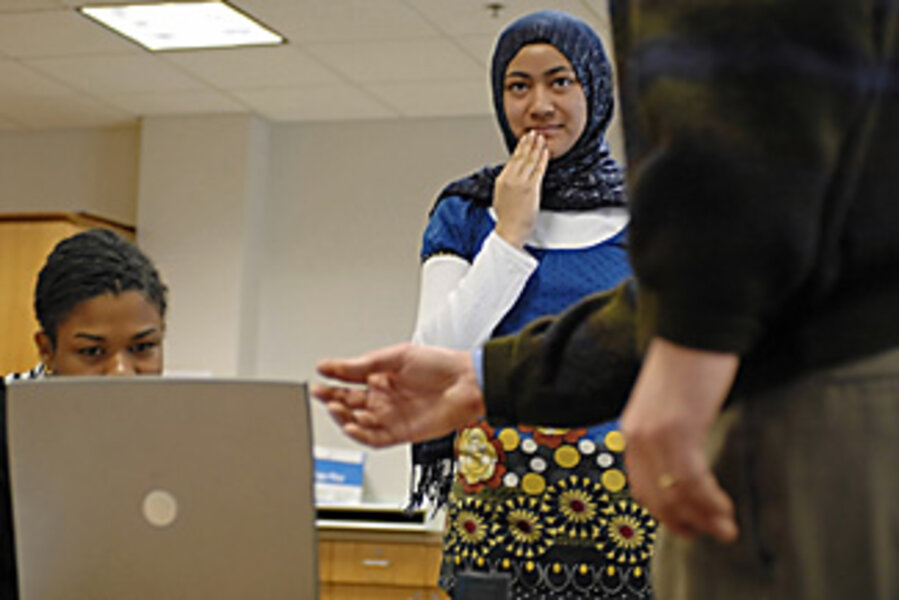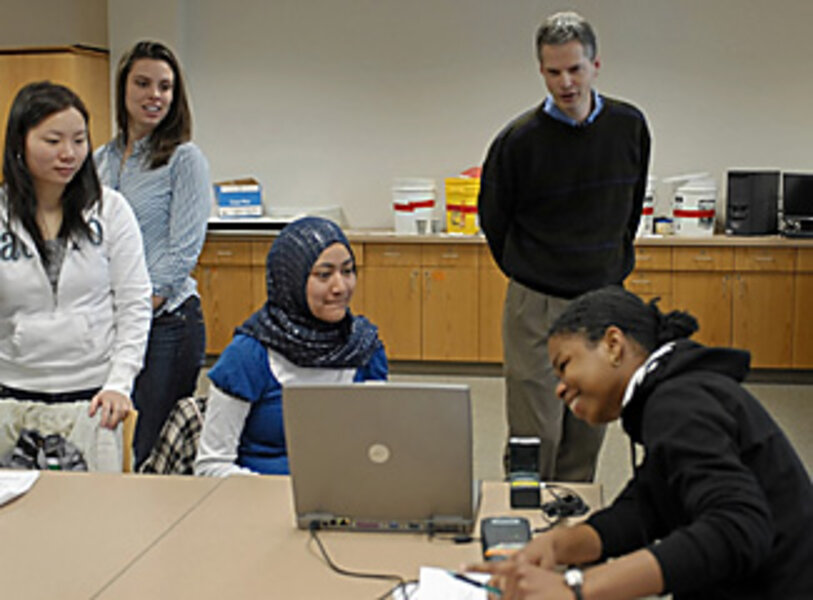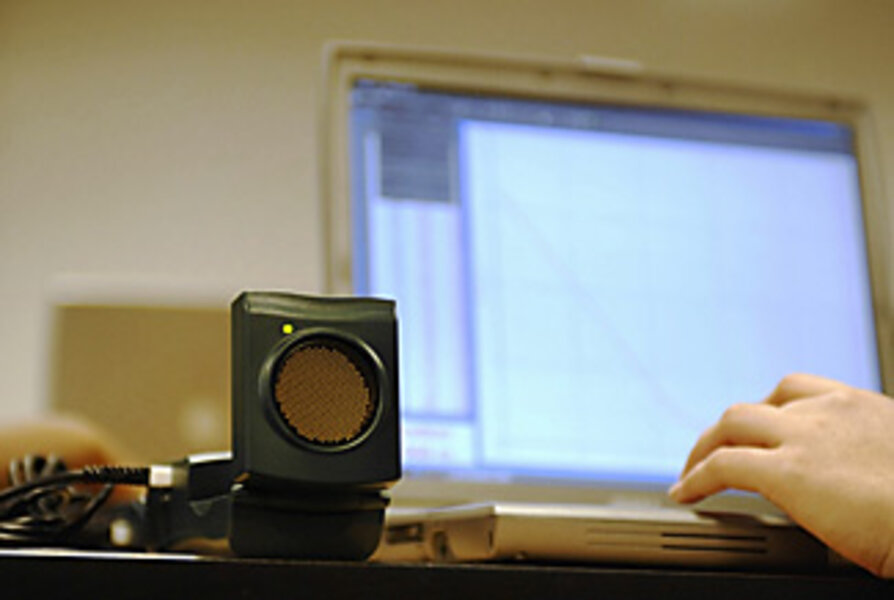How to reengineer an engineering major at a women's college
Loading...
| Northampton, Mass.
The story is legendary: Glenn Ellis arrives at his engineering class dressed as a mountain climber. He hooks a rope to the ceiling, projects snow-capped scenery on the wall, and asks a volunteer to join him in a mock ascent.
It's not an exaggeration to say that at moments like these, students hang on Professor Ellis's every word.
His continuum mechanics class had been studying the case of a major hotel walkway that collapsed in 1981. By discussing materials and structures from a climber's perspective, he not only made the lesson fun, but he also "masterfully illustrated the underlying concept of what went wrong ... in a completely different context," says Prof. Borjana Mikic. She has known Ellis since they arrived in 2001 to create the Picker Engineering Program at Smith College here.
The first women's college to offer an engineering degree, Smith is forging new paths in a field that's eager to swell its ranks in the United States. Women receive only 20 percent of bachelor's degrees in engineering, according to a new report by the National Science Board (NSB). Like a handful of other liberal arts colleges, Smith is producing graduates who've had a different type of engineering education – one that goes beyond technical training to focus on a broader context for finding solutions to humanity's problems; one that emphasizes ethics and communication; one so flexible that about half the students study abroad, which is rare, despite the multinational nature of many engineering jobs.
Ellis is known for his intense commitment to understanding how people learn and for pushing himself and his colleagues to apply those lessons. Now that he's been named one of the US Professors of the Year, he can shout his message from the mountaintop. Ellis received the $5,000 award in November from the Carnegie Foundation for the Advancement of Teaching and the Council for Advancement and Support of Education.
"It is just not good enough to teach the way that we were taught," he said during the award ceremony in Washington. "We know that doing so in engineering will surely exclude many of the young people we need to attract." Much research in recent years points to the idea that the teaching of science, technology, engineering, and math, known collectively as STEM, is crying out for improvement. "It needs to become ... much more hands-on, much more learner-centered," says Mary Moriarty, a researcher hired by Smith to conduct a two-year assessment of the Picker program. Yet the field has been slow to change, she says. The NSB report says that 83 percent of professors still use lecture and discussion as their primary methods in undergraduate classes.
Smith's program boasts a 90 percent retention rate and high participation of underrepresented minorities. Ms. Moriarty hopes to find out which elements of the experience at Smith most contribute to students' success. Female role models play a part (6 out of 10 engineering faculty here are women), but she says other factors are likely to be more important: "I think the methods being used here could probably translate very easily to other institutions that aren't all women," she says.
Ellis has done much to shape those methods. He draws on his experience teaching high school physics to bring the fun factor into his classes, for one. He has students use motion-graphing sensors to gain a deeper understanding of functions and derivatives, key building blocks in calculus. In a January math-skills class, six first- and second-year students came alive using these tools. It was a rare teaching appearance for him this year, as he's taking his first sabbatical in a 20-year career.
He encouraged the diverse group to "play around" as they graphed how their distance from the sensor changed over short bursts of time. Anna Lorenz amused the class as she tried a moonwalk to keep her line as straight as possible. "That's a Smith first!" Ellis declared gleefully.
For 2-1/2 hours the young women worked through problems in pairs as Ellis circulated, raising questions and at times folding his tall frame into a squat so he'd be eye to eye with seated students. His encouraging comments – "That's beautiful!" in response to a graph – lightened the mood.
At the end of class, he told first-year student Salma Mehter, "We want people like you in engineering." She had mentioned she was considering majoring in it, and agreed this class made her more confident.
Coach more, lecture less
When he first arrived at Smith, Ellis had to break some habits he'd formed as a student and professor in the crucible of more-traditional engineering.
"I did some things that were horribly wrong in terms of education methods," he says with the laughter of hindsight. "I would cold-call on students.... Everywhere else I'd been, no one ever called me intimidating ... but I got feedback from my [Smith] students saying my class was scary."
Current students wouldn't believe it. Consulting with a scholar in Smith's education department, Ellis discovered ways to approach classes differently: to let students work in groups and wait longer for responses to his questions; to coach more and lecture less. To make the goals of the class explicit and have students discover key concepts on their own. To assure them that mistakes are a natural part of the learning process.
The whole faculty discusses teaching methods regularly. "It's a real community feeling here," Ellis says, "and we know from the research that's absolutely critical for retaining women in engineering."
Briana Tomboulian, a senior and an occasional teaching assistant for Ellis, says the collaborative approach has worked well for her. She's leaning toward accepting a job at an environmental engineering company with a similar culture.
Ellis is the best teacher she's ever had, she says. "His classes are so welcoming and supportive.... No matter what it is, he can talk about it in such an enthusiastic way that you want to learn.... And he will explain something 100 times without getting frustrated, until you understand it."
Ellis received a teaching award at Smith last spring, but he says winning the national prize "was an absolute shock." Both came with $5,000, and he spent the first prize on a backhoe because he loves digging in the dirt. But he feels a large responsibility attached to the national award: "It's a challenge to me to do my job better."
Linda Jones, director of the Picker program, says the national award also affirmed the college was right to take the risks it did in launching the engineering degree. She recalls the Provost wiping away tears during the award presentation, a symbol of the hard work – and heart and soul – that people poured into the effort.
Another signal that they're on the right track is feedback from employers. During a visit to a Ford plant, an engineer came off the plant floor to talk with Ms. Jones. She was a Smith grad who had been pulled out of a mandatory writing class for new employees after the first day and asked to facilitate it instead.
An early start for engineers
Ellis offers an education course at Smith to prepare people to teach math and science at the K-12 level and he conducts workshops for teachers. "If you care about getting women in engineering, you had better go to the high school, middle school, and elementary level," he says.
He and a colleague are working on a fiction book that will be packaged with preengineering activities for middle-schoolers. It features an eighth-grade girl who faces an ethical dilemma similar to one that her mother, an engineer, is experiencing at work. Students who get hooked into the story will have a chance to learn the basics of computer-aided design by drafting a bedroom setup; they'll explore artificial intelligence through conversations with "chatterbots" – computer programs that imitate human conversation.
Smith students serve as his research assistants. "I have zero chance of relating to a middle-school girl," Ellis says, perhaps too modestly.
His "creative team" of students brought in a bunch of teen-girl magazines. "We're trying to take all the evil ways of luring girls into these idiotic things, and lure them into engineering," he says with a subversive grin.
The power of community
If they end up being lured into a place that's as supportive as Smith seems to be, they are more likely to stay with it.
Ellis recalls many conversations in a student lounge adjacent to his previous office. That's how he learned to stop giving tests where the average was expected to be a 40 (a time-honored tradition in engineering), because students who scored way above the average would nevertheless cry because they felt they did poorly. That's also where he witnessed the power of community.
"They were so tight," Ellis says. "If a student was considering leaving the program, her classmates would be like, 'Hey, we need you; we love you; you can't go!' "








